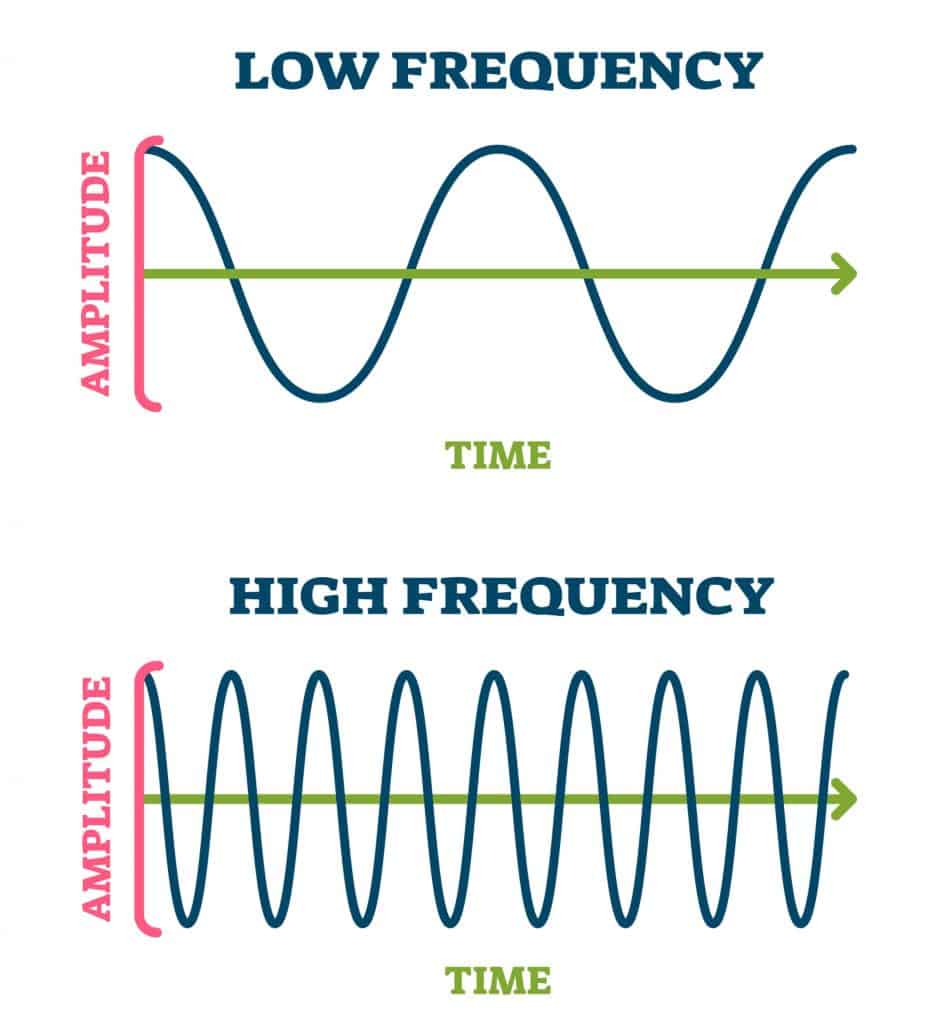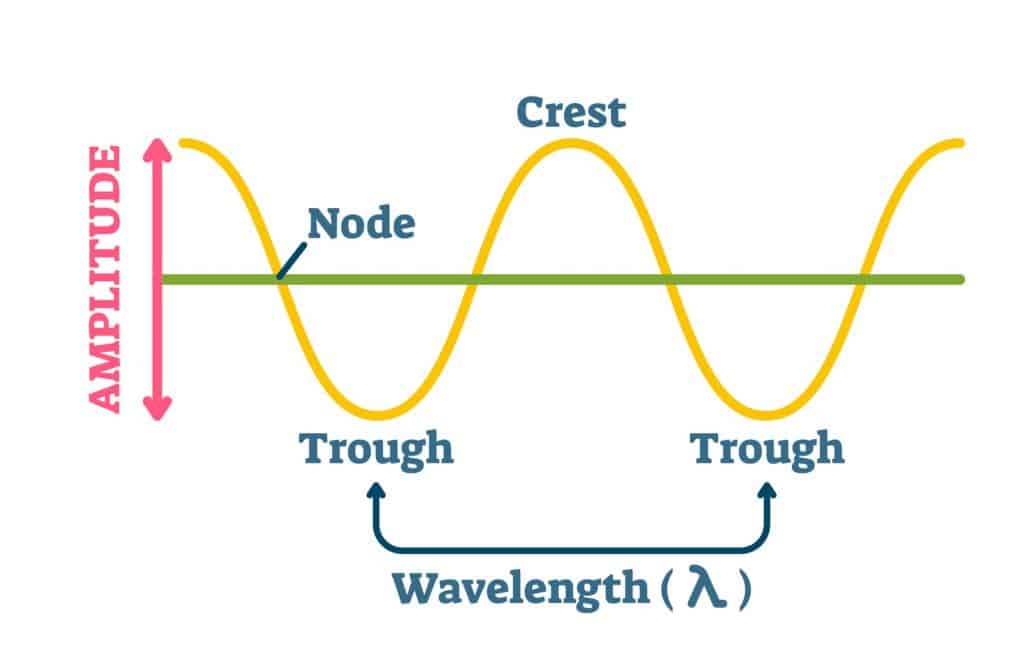We hear sounds, see light and colors, feel warmth radiating from a fire. All these are waves, except they are of different wavelengths. While sound waves require a medium to travel through, light can also travel through a vacuum, but they are both still waves.
All waves can be represented by a waveform. A waveform gives us a visual representation of the wave’s amplitude and frequency, so we can gauge its intensity as well as where it lies within the mechanical or electromagnetic wave spectrum.
Despite the differences between the way sound and light waves travel or propagate (particles in a sound wave move parallel to the direction of travel of the wave and is referred to as a longitudinal wave, particles in a light wave move in a direction perpendicular to the direction of travel of the wave and is referred to as a transverse wave), they are still both defined in terms of their amplitude and frequency.
Sound Waves
Waves are energy, transferring from one point in space to another. When we refer to a sound, we indirectly refer to its frequency by indicating how low or high pitched the sound is, and its amplitude by how loud or soft it is.
Similarly, when referring to visible light, the frequency of the light will determine which color we see, with red being at the low end and violet at the high end of the spectrum, while amplitude indicates its brightness.
A wave is created when a vibrating source causes a periodic disturbance in the initial particle in a medium. It in turn disturbs the next particle, which disturbs the next, and so on, causing a wave to propagate along the medium as energy moves or transfers from particle to particle.
Along the wave, each individual particle vibrates at the same frequency as the original source. Hence, the period of vibration of each particle within the medium, is therefore also equal to the period of vibration of the source.
What is Frequency?
The unit of measurement of frequency is the hertz (Hz). Because of the great range of frequencies from the low end of the spectrum (sound waves) to the high end (gamma rays), kilohertz (kHz), megahertz (MHz), gigahertz (GHz), terahertz (THz), etc., are commonly used.
Learn More: Why are Ultrasonic Frequencies Not Audible to Humans?
One hertz is one full cycle or one complete oscillation of the wave completed in one second. If we take a sine wave as an example, a complete cycle is when the wave starts at zero (or at rest), ascends to a positive peak, then descends through zero down to a negative peak, and back to the original state at rest.
If several cycles of a wave occur in a second, then the number of cycles (expressed as cycles per second) is also the frequency of the wave. Thus, the frequency of a wave can be expressed as 10 cycles per second (10 cps or 10 c/s), or as 10 Hertz (10 Hz).

The amount of time required to complete one cycle, is the period of the wave (i.e. it is the inverse of its frequency). If a wave has a frequency of 10 Hz, it completes 10 cycles in one second, and therefore one cycle has a duration of one tenth of a second, which is its period.
When referring to waves at the extreme high end of the electromagnetic spectrum, wavelength rather than frequency is often used. Wavelength in reference to frequency can be calculated with the formula λ = v/f (where λ = wavelength, v = speed of the wave, f = frequency).
Wavelength and frequency are directly related, so that if a wave’s wavelength increases, its frequency decreases, and vice versa, while speed remains constant.
What is Amplitude?
While frequency measures how many wave cycles occur in a specified period of time (typically a second), amplitude is a measure of a wave’s intensity. If we assume that the same musical note is played loudly and then softly, while it’s frequency does not change, its volume, intensity, amplitude, call it what you like, does.
A yellow light source can shine dimly or brightly. Again, it’s frequency remains the same and it still projects a yellow beam, but the intensity or brightness of the light changes. So while with sound we call it volume, and for light brightness, in all cases we are referring to one and the same property, the wave’s amplitude.
The amplitude of a wave corresponds to the maximum distance a particle is displaced from its state of rest, along the medium in which the wave is traveling. Referring to our earlier definition of a wave, namely that “waves are energy, transferring from one point in space to another”, amplitude therefore represents the wave’s energy.

If we look at the waveform of sine wave, amplitude is the distance between the crest (positive peak) and trough (negative peak) divided by two. Since it is a measure of displacement, its value is expressed in meters.
What are the Differences Between Frequency and Amplitude
If we refer to the graphical representation of a waveform (e.g. a sine wave), typically, frequency is represented by time plotted along the x or horizontal axis, and amplitude along the y or vertical axis. Changes in a wave’s frequency could then be represented by cycles in the waveform that are more contracted or expanded, depending on whether the frequency is higher or lower respectively.
Amplitude on the other hand, would produce taller peaks and deeper troughs, representing an increase in the amount of energy of the wave. While both amplitude and frequency are key properties of any wave, they are not interdependent.
Unlike frequency and wavelength, where a change in the wavelength will have an inverse effect on the frequency (i.e. the larger the wavelength, the smaller the frequency), a change in amplitude will not have any effect on the frequency of the wave.
Another consideration is how waves are affected by the medium through which they travel, and what happens as they pass from one medium to another. What remains constant is the frequency of a wave, which does not change from medium to medium. So what does change.
The speed of sound through air is around 343 meters per second (m/s), whereas it travels at 1,481 m/s in water, and 5,120 m/s in iron. Unlike light waves and other electromagnetic waves, sound cannot travel through a vacuum. This is why sound waves are also referred to as mechanical waves.
In contrast, the speed of light through the vacuum of space is around 300,000 kilometers per second. It drops to 225,000 kilometers per second in water and 200,000 kilometers per second in glass. Hence, the speed of a wave is affected by the medium the wave travels through. Unlike sound waves, light waves can travel through a vacuum and are referred to as electromagnetic waves.
From the formula λ = v/f, we can see that since the speed of the wave changes as it passes from one medium to another, yet the frequency remains constant, then it stands that the wavelength will also change. When a wave travels from one medium into a denser medium, it slows down in speed and therefore its wavelength decreases.
Amplitude is also affected when a wave passes from one medium into another. Some of the wave’s energy is reflected, and so the amplitude is damped or attenuated. Furthermore, when a wave is traveling through the medium, its amplitude is attenuated over distance, due to scattering and absorption.
Since waves transfer energy, with mechanical waves such as sound waves, the transfer of energy of the wave is dependent on both the wave’s amplitude and frequency. Since each cycle carries some quantity of energy, the more cycles per second (i.e. the higher the frequency), the more energy that will be transferred.
This is why low pitched sounds tend to travel further than high pitched. High pitched sounds complete more cycles per second and so use up or require a lot more energy. With electromagnetic waves such as light, the energy transfer is only dependent on the wave’s amplitude and is independent of its frequency.
Summing up, we can conclude that the difference between frequency and amplitude is that frequency remains constant, irrespective of the type of wave (whether it be mechanical or electromagnetic), or the medium through which the wave travels.
In contrast, the amplitude of a wave is affected by distance and the medium through which the wave travels. In the case of mechanical waves, amplitude is also affected by the frequency of the wave. It could be said that frequency determines how a wave transfers energy, while amplitude how much energy is transferred.

